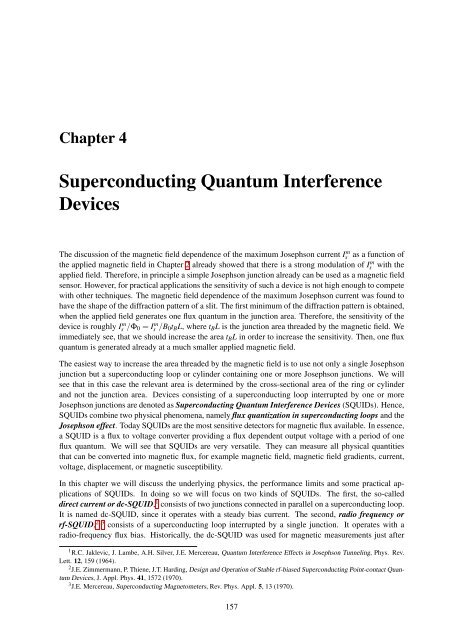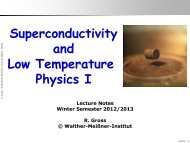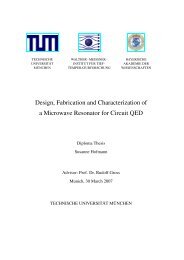Applied Superconductivity - Walther Meißner Institut - Bayerische ...
Applied Superconductivity - Walther Meißner Institut - Bayerische ...
Applied Superconductivity - Walther Meißner Institut - Bayerische ...
- No tags were found...
You also want an ePaper? Increase the reach of your titles
YUMPU automatically turns print PDFs into web optimized ePapers that Google loves.
Chapter 4Superconducting Quantum InterferenceDevicesThe discussion of the magnetic field dependence of the maximum Josephson current Ism as a function ofthe applied magnetic field in Chapter 2 already showed that there is a strong modulation of Ism with theapplied field. Therefore, in principle a simple Josephson junction already can be used as a magnetic fieldsensor. However, for practical applications the sensitivity of such a device is not high enough to competewith other techniques. The magnetic field dependence of the maximum Josephson current was found tohave the shape of the diffraction pattern of a slit. The first minimum of the diffraction pattern is obtained,when the applied field generates one flux quantum in the junction area. Therefore, the sensitivity of thedevice is roughly Is m /Φ 0 = Is m /B 0 t B L, where t B L is the junction area threaded by the magnetic field. Weimmediately see, that we should increase the area t B L in order to increase the sensitivity. Then, one fluxquantum is generated already at a much smaller applied magnetic field.The easiest way to increase the area threaded by the magnetic field is to use not only a single Josephsonjunction but a superconducting loop or cylinder containing one or more Josephson junctions. We willsee that in this case the relevant area is determined by the cross-sectional area of the ring or cylinderand not the junction area. Devices consisting of a superconducting loop interrupted by one or moreJosephson junctions are denoted as Superconducting Quantum Interference Devices (SQUIDs). Hence,SQUIDs combine two physical phenomena, namely flux quantization in superconducting loops and theJosephson effect. Today SQUIDs are the most sensitive detectors for magnetic flux available. In essence,a SQUID is a flux to voltage converter providing a flux dependent output voltage with a period of oneflux quantum. We will see that SQUIDs are very versatile. They can measure all physical quantitiesthat can be converted into magnetic flux, for example magnetic field, magnetic field gradients, current,voltage, displacement, or magnetic susceptibility.In this chapter we will discuss the underlying physics, the performance limits and some practical applicationsof SQUIDs. In doing so we will focus on two kinds of SQUIDs. The first, the so-calleddirect current or dc-SQUID, 1 consists of two junctions connected in parallel on a superconducting loop.It is named dc-SQUID, since it operates with a steady bias current. The second, radio frequency orrf-SQUID, 2,3 consists of a superconducting loop interrupted by a single junction. It operates with aradio-frequency flux bias. Historically, the dc-SQUID was used for magnetic measurements just after1 R.C. Jaklevic, J. Lambe, A.H. Silver, J.E. Mercereau, Quantum Interference Effects in Josephson Tunneling, Phys. Rev.Lett. 12, 159 (1964).2 J.E. Zimmermann, P. Thiene, J.T. Harding, Design and Operation of Stable rf-biased Superconducting Point-contact QuantumDevices, J. Appl. Phys. 41, 1572 (1970).3 J.E. Mercereau, Superconducting Magnetometers, Rev. Phys. Appl. 5, 13 (1970).157
















